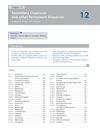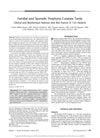66-Year-Old Woman With Painless Vesicular Lesions
July 2009
in “
Mayo Clinic Proceedings
”
TLDR A 66-year-old woman with skin lesions and other symptoms improved after treatment for porphyria cutanea tarda.
A 66-year-old woman presented with painless vesicular lesions, diagnosed as porphyria cutanea tarda (PCT) based on elevated urinary porphyrins and normal urinary PBG levels. PCT is associated with conditions like hemochromatosis and hepatitis C, necessitating screening for these disorders. The patient had elevated iron and ferritin levels, and genetic testing confirmed hereditary hemochromatosis. Treatment involved phlebotomy to reduce iron stores, leading to significant improvement in her symptoms. Long-term management included avoiding alcohol, estrogens, and iron supplements, and using topical sunscreens to prevent exacerbations. Regular monitoring of serum ferritin and porphyrin levels was essential for assessing therapeutic efficacy.


